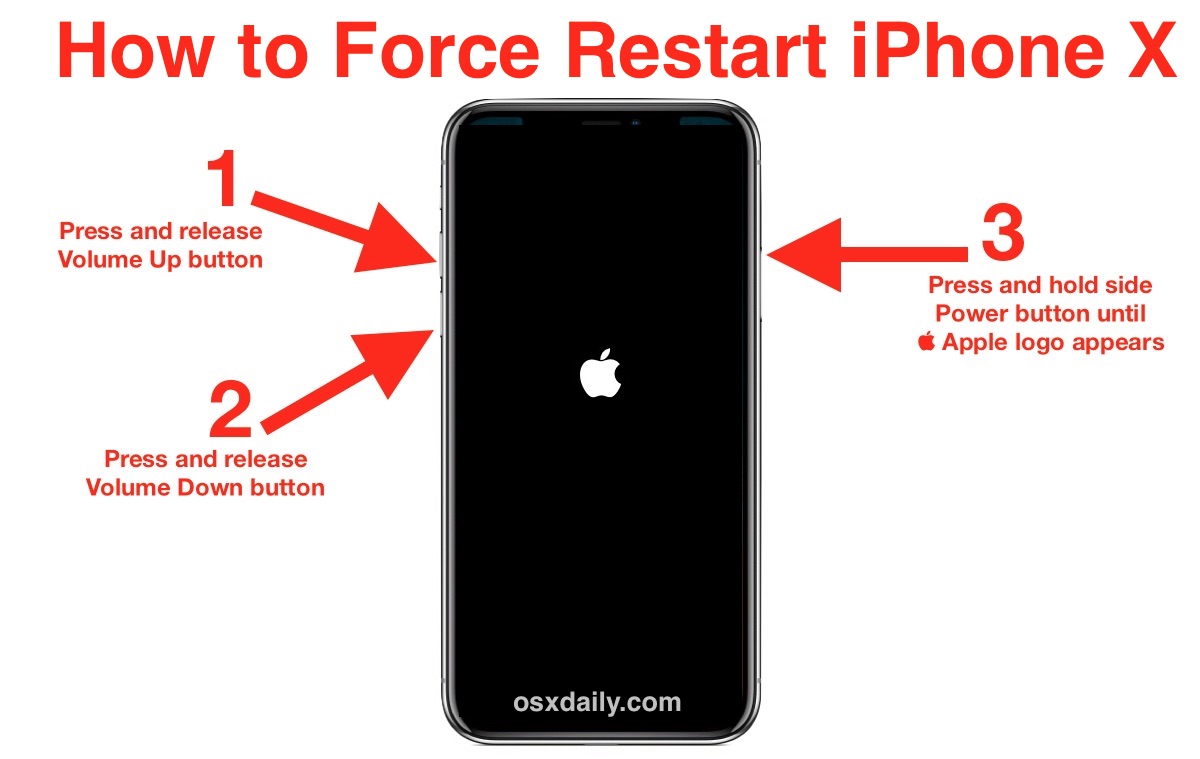How to force restart iPhone, press and release the Volume Up button, then the Volume Down button, and hold the Side button. Release when the Apple logo appears.
A force restart can be a lifesaver for your iPhone. It helps resolve unresponsive screens and minor software glitches. This method is quick and doesn’t require any special tools or technical expertise. Understanding how to force restart your iPhone can save you time and frustration.
It is a simple yet effective way to get your device back to normal operation. Whether your phone is frozen or experiencing minor issues, a force restart is often the first step in troubleshooting. Knowing this basic technique is essential for every iPhone user.
How to Force Restart iPhone?

Introduction To Force Restarting An Iphone
Sometimes your iPhone may freeze or become unresponsive. This can be frustrating. A quick solution is to force restart your iPhone. This process does not delete your data. It simply refreshes your device’s memory.
The Importance Of A Fresh Start
A fresh start can solve many issues. It clears the iPhone’s temporary memory. This helps in speeding up the device. It also resolves minor software glitches.
Force restarting is like giving your iPhone a short nap. It wakes up refreshed and ready to work again. This simple trick can extend your phone’s life.
When To Consider A Force Restart
- Your iPhone screen is frozen.
- Apps are not opening or crashing.
- Your iPhone is stuck on the Apple logo.
- Screen is black and unresponsive.
- iPhone is slow and laggy.
| iPhone Model | Force Restart Steps |
|---|---|
| iPhone 8 and Later |
|
| iPhone 7 and 7 Plus |
|
| iPhone 6s and Earlier |
|
Force restarting is a simple yet effective solution. It helps in keeping your iPhone running smoothly.
Recognizing A Non-responsive Iphone
Sometimes, your iPhone may stop responding. Recognizing the signs is the first step. A non-responsive iPhone can disrupt daily activities. Learn to identify the problem quickly.
Common Signs Of Freezing
A frozen iPhone often shows specific signs. Here are some common ones:
- Screen remains black or unresponsive.
- Apps do not open or close.
- Touchscreen does not react to taps or swipes.
- Buttons do not work as expected.
These signs indicate your iPhone needs a restart. Recognize these signs to act promptly.
Distinguishing Between Software And Hardware Issues
Identify if the issue is software-related or hardware-related. This helps in choosing the correct solution.
Software issues usually involve:
- Apps crashing or not loading.
- System updates causing glitches.
- Overloaded memory.
Hardware issues often involve:
- Damaged buttons or ports.
- Physical damage to the screen.
- Battery malfunctions.
If software-related, a restart often fixes the problem. Hardware issues may need professional repair.
Recognizing a non-responsive iPhone is crucial. Knowing the signs and causes helps solve the problem quickly.
Force Restart Steps For Different Iphone Models
If your iPhone is frozen or unresponsive, you may need to force restart it. This guide will help you force restart your iPhone, regardless of the model. Follow the steps below based on your specific iPhone model.
Iphone 8 And Later
For iPhone 8 and newer models, follow these steps:
- Quickly press and release the Volume Up button.
- Quickly press and release the Volume Down button.
- Press and hold the Side button until the Apple logo appears.
Iphone 7 And 7 Plus
If you have an iPhone 7 or 7 Plus, use these steps:
- Press and hold the Volume Down button.
- Simultaneously, press and hold the Side button.
- Keep holding both buttons until the Apple logo shows up.
Iphone 6s, 6s Plus, And Se (1st Generation)
For older models like iPhone 6s, 6s Plus, and SE, follow these steps:
- Press and hold the Home button.
- At the same time, press and hold the Top (or Side) button.
- Keep holding both buttons until the Apple logo appears.
Troubleshooting Post-restart Issues
Restarting your iPhone can solve many problems. But sometimes, new issues arise after a restart. This section helps you troubleshoot those problems. Follow the steps below to ensure your iPhone works smoothly.
Assessing Functionality After A Restart
Check if your iPhone performs as expected after a restart. Follow these steps:
- Test your touch screen. Tap and swipe to see if it works.
- Open a few apps. Ensure they load without crashing.
- Make a call. Verify the microphone and speaker functions.
- Send a text. Confirm messages are sent and received.
- Check Wi-Fi and Bluetooth. Ensure they connect properly.
If everything works, your iPhone is fine. If you spot any problems, read on.
What To Do If Problems Persist
If issues continue after a restart, try these solutions:
- Update iOS: Go to
Settings > General > Software Update. Install any available updates. - Reset network settings: Navigate to
Settings > General > Reset > Reset Network Settings. This clears Wi-Fi passwords and connections. - Check for app updates: Open the App Store. Tap on your profile, then
Update All. - Free up space: Delete unused apps and large files. Go to
Settings > General > iPhone Storage. - Contact support: If problems persist, contact Apple Support for further assistance.
These steps often resolve common issues. Keep your iPhone updated and maintained for the best performance.
The Role Of Ios Updates In Iphone Stability
iOS updates play a crucial role in maintaining iPhone stability. These updates bring new features, fix bugs, and improve security. Regular updates ensure that your iPhone runs smoothly and efficiently.
How Updates Improve Performance
iOS updates enhance performance in several ways:
- Bug fixes: Address issues that can cause crashes or slow performance.
- Security patches: Protect against vulnerabilities and threats.
- New features: Introduce improvements that optimize the user experience.
- System optimizations: Refine processes to use resources better.
Updating your iPhone ensures it functions at its best. It helps in reducing glitches and enhancing overall stability.
Checking For And Installing Updates
Follow these steps to check and install updates:
- Open Settings on your iPhone.
- Scroll down and tap General.
- Tap Software Update.
- Wait for your iPhone to check for updates.
- If an update is available, tap Download and Install.
Ensure your iPhone is connected to Wi-Fi and has sufficient battery life. Updating regularly keeps your device secure and efficient.

Backup Strategies Before A Force Restart
Force restarting your iPhone can fix many issues. But, it may also lead to data loss. Hence, backing up your data is crucial. Below are some effective backup strategies.
Using Icloud For Backup
iCloud offers a convenient way to back up your iPhone. Here is how you can do it:
- Connect your iPhone to a Wi-Fi network.
- Go to Settings > [your name] > iCloud.
- Tap iCloud Backup.
- Tap Back Up Now.
Make sure your backup completes. You can check this under Settings > [your name] > iCloud > iCloud Backup. The date and time of your last backup will appear.
Local Backups Via Itunes Or Finder
Creating a local backup is another solid strategy. This can be done using iTunes or Finder. Follow these steps:
- Connect your iPhone to your computer.
- Open iTunes or Finder.
- Select your iPhone from the list of devices.
- Click Back Up Now.
Local backups are stored on your computer. You can also encrypt your backup for extra security. To do this, check the box labeled Encrypt local backup before starting the backup.
| Backup Method | Steps |
|---|---|
| Using iCloud |
|
| Local via iTunes/Finder |
|
Backing up your iPhone ensures your data is safe. Whether you use iCloud or iTunes/Finder, keeping a backup is a smart move. Always make sure your data is backed up before a force restart.
Advanced Solutions For Persistent Problems
If your iPhone problems continue, try advanced solutions. These methods resolve deeper issues. They often require more technical steps. This guide covers two such solutions: DFU Mode and Recovery Mode. For persistent issues, consider seeking professional help.
Dfu Mode And Recovery Mode
DFU Mode stands for Device Firmware Update. This mode allows your iPhone to interface with iTunes. It bypasses the current OS and firmware. Entering DFU Mode can fix severe issues.
- Connect your iPhone to a computer with iTunes.
- Press and hold the Power button for 3 seconds.
- Hold the Volume Down button while holding the Power button.
- Keep holding both buttons for 10 seconds.
- Release the Power button but continue holding the Volume Down button.
- iTunes will detect an iPhone in recovery mode. Your screen should remain black.
Recovery Mode is another solution. It can restore your iPhone to factory settings. This process erases all data.
- Connect your iPhone to a computer with iTunes.
- Quickly press and release the Volume Up button.
- Quickly press and release the Volume Down button.
- Press and hold the Side button until the recovery mode screen appears.
- iTunes will prompt you to update or restore your iPhone.
Seeking Professional Assistance
If DFU or Recovery Mode fails, seek professional help. Visit an Apple Store or authorized service provider. They have tools to diagnose and fix your iPhone. Professionals can handle complex issues safely.
Here is a quick comparison table for DFU Mode and Recovery Mode:
| Mode | Function | When to Use |
|---|---|---|
| DFU Mode | Bypasses OS and firmware | Severe issues, firmware problems |
| Recovery Mode | Restores to factory settings | General issues, software problems |

Preventative Measures And Best Practices
Ensuring your iPhone operates smoothly requires consistent care. By following preventative measures and best practices, you can avoid frequent force restarts. Below, we discuss essential routines and tips to keep your iPhone in top condition.
Regular Maintenance Routines
Regular maintenance routines are crucial for a healthy iPhone. These steps can help you prevent performance issues:
- Update Software: Always update to the latest iOS version.
- Clear Cache: Regularly clear app cache to free up space.
- Restart Weekly: Restart your iPhone once a week.
- Delete Unused Apps: Remove apps you no longer use.
- Manage Storage: Regularly check and manage storage settings.
Monitoring Iphone Health
Monitoring iPhone health helps you identify potential problems early. Use these tips to keep an eye on your iPhone’s performance:
| Action | Benefit |
|---|---|
| Check Battery Health: | Ensures battery longevity and alerts on issues. |
| Review Analytics: | Identifies apps causing crashes or slowdowns. |
| Monitor Storage: | Avoids storage-related performance issues. |
Using these preventative measures and best practices, you can keep your iPhone running smoothly. Consistent care helps avoid the need for frequent force restarts.
Faqs On Force Restarting An Iphone
Force restarting an iPhone can solve many issues. This section addresses common questions about the process. Let’s debunk myths and address user concerns.
Debunking Common Myths
Many people believe force restarting can harm your iPhone. This is not true. Force restarting is a safe method to fix minor issues. It does not delete any data or apps.
Another myth is that force restarting affects battery life. This is also false. A force restart does not impact battery health or usage.
Addressing User Concerns
Some users worry about how often they should force restart their iPhone. You should only do it when necessary. If your iPhone is frozen or unresponsive, a force restart is helpful.
Others wonder if force restarting is different for various iPhone models. Yes, the steps vary slightly. But the core process remains the same.
| iPhone Model | Steps to Force Restart |
|---|---|
| iPhone 8 and later |
|
| iPhone 7 and 7 Plus |
|
| iPhone 6s and earlier |
|
Remember, force restarting is not a daily task. Use it only to solve specific issues.
Conclusion
Restarting your iPhone can solve many issues quickly. Follow the steps outlined to force restart your device. This simple process can save you time and frustration. Keep this guide handy for future reference. Your iPhone will be back to normal in no time.
Happy troubleshooting!



